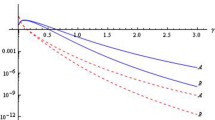Abstract
The quasi-classical approximation is used for establishing the positions of the classical turning points of an electron in an image-potential state exposed to an electric field of arbitrary strength perpendicular to the metal surface. It is demonstrated that the behavior of the system in electric fields of different directions is fundamentally different, which makes the dynamics of the low-dimensional system qualitatively different from that of its three-dimensional analog. The electric field strength leading to transition from the tunnel ionization regime to the regime of above-barrier decomposition is determined. The wavefunction of the bound electron state, which explicitly takes into account the influence of the electric field, is expressed in terms of elliptic integrals. The quantization condition is formulated, and the linear and quadratic in the field corrections to the electron energy are found. It is demonstrated that the difference between the linear Stark effect calculated by means of the perturbation theory and the quasi-classical energy shift in a weak field rapidly decreases with increasing quantum level number.
Similar content being viewed by others
References
Nanoscale Science and Technology, Ed. by R. Kelsall, I. W. Hamley, and M. Geoghegan (Wiley, Chichester, 2005).
P. M. Echenique and M. E. Uranga, Surf. Sci. 247, 125 (1991).
P. M. Echenique, R. Berndt, E. V. Chulkov, T. Fauster, A. Goldmann, and U. Höfer, Surf. Sci. Rep. 52, 219 (2004).
S. V. Eremeev, S. S. Tsirkin, and E. V. Chulkov, Phys. Solid State 52, 1768 (2010).
L. D. Landau and E. M. Lifshitz, Course of Theoretical Physics, Vol. 8: Electrodynamics of Continuous Media (Nauka, Moscow, 2002; Pergamon, New York, 1984).
P. M. Echenique and M. E. Uranga, Surf. Sci. 247, 125 (1991).
E. V. Chulkov, V. M. Silkin, and P. M. Echenique, Surf. Sci. 391, L1217 (1997).
E. V. Chulkov, V. M. Silkin, and P. M. Echenique, Surf. Sci. 437, 330 (1999).
Th. Fauster, Ch. Reuß, I. L. Shumay, and M. Weinelt, Chem. Phys. 251, 111 (2000)
Th. Fausterand and M. Weinelt, J. Electron Spectr. Rel. Phenom. 114–116, 269 (2001).
P. M. Echenique and J. B. Pendry, Prog. Surf. Sci. 32, 111 (1990).
I. L. Shumay, U. Höfer, Ch. Reuß, U. Thomann, W. Wallauer, and Th. Fauster, Phys. Rev. B 58, 13974 (1998).
W. S. Fann, R. Storz, and J. Bokor, Phys. Rev. B 44, 10980 (1991).
E. V. Chulkov, A. G. Borisov, J. P. Gauyacq, D. Sánchet-Portal, V. M. Silkin, V. P. Zhukiv, and P. M. Echenique, Chem. Rev. 106, 4160 (2006).
P. M. Echenique, R. Berndt, E. V. Chulkov, Th. Fauster, A. Goldman, and U. Höfer, Surf. Sci. 52, 219 (2004).
P. A. Golovinskii and M. A. Preobrazhenskii, Opt. Spectrosc. 118, 191 (2015).
P. A. Golovinskii and M. A. Preobrazhenskii, Tech. Phys. Lett. 41, 720 (2015).
R. Langer, Phys. Rev. 15, 669 (1937).
B. M. Karnakov and V. P. Krainov, WKB Approximation in Atomic Physics (Springer, Berlin, 2013).
L. D. Landau and E. M. Lifshitz, Course of Theoretical Physics, Vol. 3: Quantum Mechanics: Non-Relativistic Theory (Nauka, Moscow, 1974; Pergamon, New York, 1977).
A. B. Migdal, Qualitative Methods in Quantum Theory (Nauka, Moscow, 1975; Benjamin, Reading, MA, 1977).
M. Abramowitz and I. Stegun, Handbook of Mathematical Functions (Dover, New York, 1965), Chap. 17.
Author information
Authors and Affiliations
Corresponding author
Additional information
Original Russian Text © P.A. Golovinskii, M.A. Preobrazhenskii, 2017, published in Optika i Spektroskopiya, 2017, Vol. 122, No. 1, pp. 133–140.
Rights and permissions
About this article
Cite this article
Golovinskii, P.A., Preobrazhenskii, M.A. Quasi-classical description of the stark effect for an electron in an image-potential state. Opt. Spectrosc. 122, 120–127 (2017). https://doi.org/10.1134/S0030400X1701009X
Received:
Published:
Issue Date:
DOI: https://doi.org/10.1134/S0030400X1701009X



